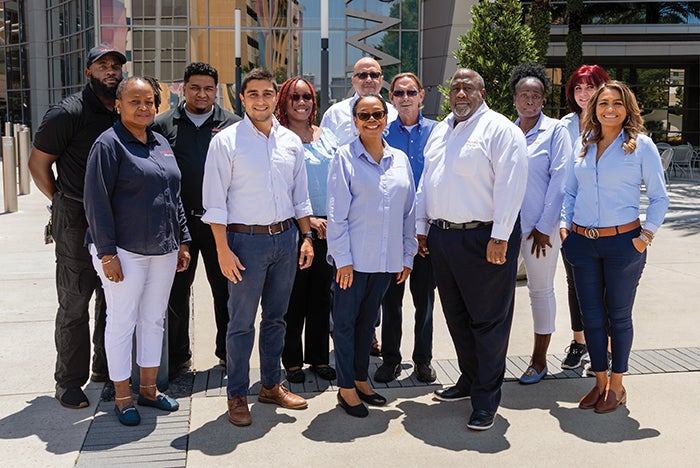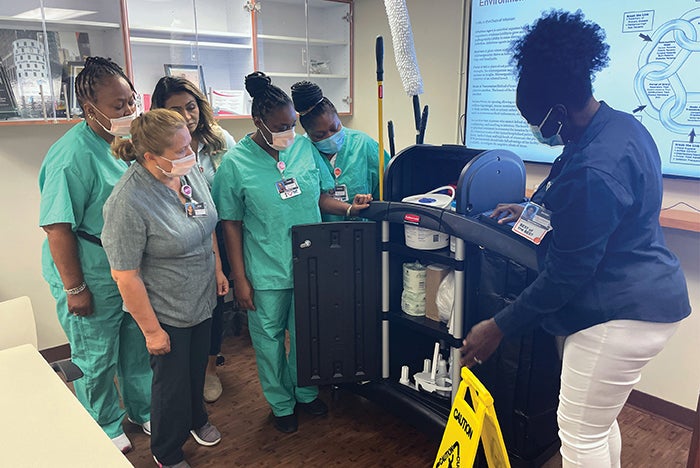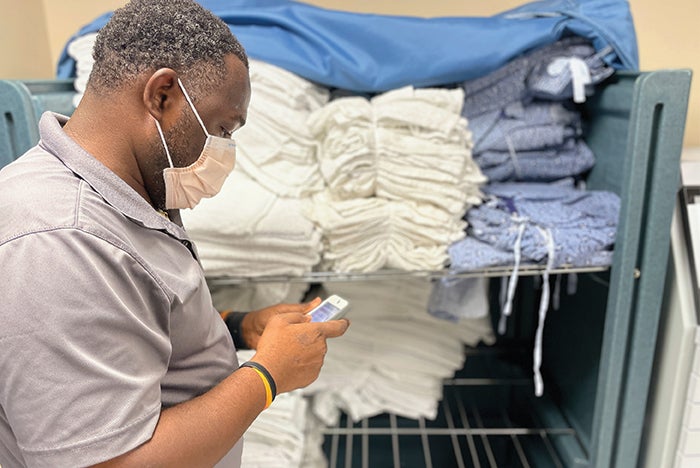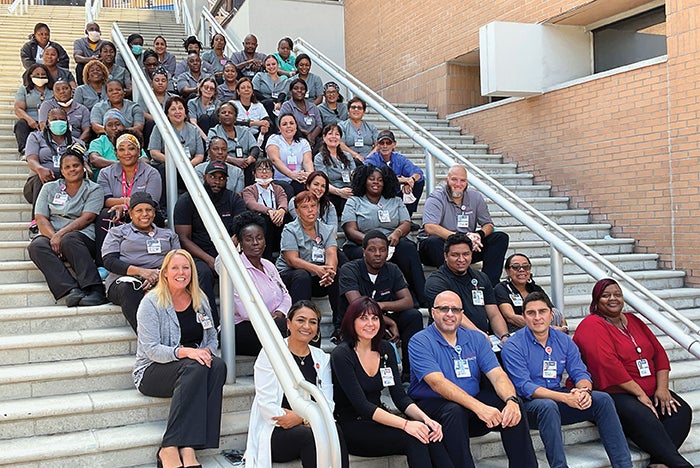Orlando Regional Medical Center excels in year of transition and uncertainty

FRONT ROW, FROM LEFT: Jean Pamphile, CHEST, CNACC, trainer; Javier Correa, operations manager; Marcia Richardson, CHEST, administrative assistant; Michael Parker, CMIP, T-CHEST, T-CSCT, T-CNACC, director; and Luz Martinez, CHEST, training support. BACK ROW, FROM LEFT: Immanuel Enslow, CHEST, patient tower supervisor; Chris Ishwardeen, CHEST, patient tower supervisor; Natesha Bentley, CNACC, allied and support supervisor; Edwin Mendez, CHEST, linen service supervisor; Robin Bonney, CHEST, CNACC, supply and equipment technician; Devona Louder, T-CHEST, T-CSCT, CNACC, lead trainer; and Lyndsey Tysiac, patient movement supervisor.
Michael Parker, CMIP, T-CHEST, T-CSCT, T-CNACC, director of environmental services (EVS) and corporate linen at Orlando Health’s Orlando Regional Medical Center (ORMC), recalls that 2021 was a year of challenging transition with the department’s leadership and a time of unprecedented uncertainty with the global COVID-19 pandemic.
“Yet, even though our leadership transitioned from 30 years of relying on outside contractor support to an in-house program, and despite the pandemic, we remained successful, improving in key areas critical to patient care and team member support,” he says. “We reduced our turnaround time for patient rooms and exceeded the goals for our Hospital Consumer Assessment of Healthcare Providers and Systems (HCAHPS) courtesy and cleanliness scores. Leadership’s employee engagement initiatives helped reduce our team member turnover rate, too.”
These and other efforts helped ORMC’s EVS department earn the 2021 Orlando Health Marilyn King Award — the highest internal award that recognizes departments for providing remarkable patient experiences — as well as the Association for the Health Care Environment EVS Department of the Year Award in the 500-plus bed category. “These accomplishments reflect our commitment to being a productive partner with team members to help ensure patients receive a timely, appropriate level of care and experience a clean facility,” Parker says.
Putting patients first
Parker stresses that improvements are continually made within the department to address the patient experience. When necessary, a detailed plan is drafted that involves EVS technicians and multiple disciplines. If a goal or benchmark is missed, EVS unites with other departments to recover.
“For example, a military veteran patient was unhappy with the level of care he received. Involved departments collaborated to make sure his concerns were addressed with additional environmental services provided. Volunteer services decorated his room in red, white and blue and gave him a giant poster signed by the patient’s care team and hospital leadership,” he notes.

Devon Louder, T-CHEST, T-CSCT, CNACC, lead trainer, trains a new hiring group on cart setup.
For example, wasted time locating phones for status updates or reporting cleaning process delays has been eliminated for technicians. Now, technicians receive room assignments right in their apps and place them “in progress,” “clean” or “on hold” (if necessary) with a description of the reason. They also can send personal messages to bed coordinators for requests like bed delivery to a room or additional supplies required to complete tasks.
The department recently upgraded its ultraviolet (UV) disinfection technology as well, providing a higher level of optimal disinfection in just three minutes, greater portability via units that can move around easily and fit into smaller spaces, better compatibility with more surfaces and materials, lower operating costs and requiring minimal maintenance. The UV technology is nontoxic, so there are no fumes or chemicals.
“We also use color-changing wipes technology as a training tool to teach the mechanics of friction cleaning to EVS technicians so they can self-monitor and be more confident in their cleaning,” Parker says. “This technology ensures that touchpoints are cleaned properly by providing real-time color visualization, best disinfection practices and real-time compliance for our most vulnerable patients,” he adds.
Listening to concerns
EVS leadership has implemented several team member engagement initiatives to boost retention and minimize turnover. For example, it enhanced intradepartmental communication by creating a department group email address to communicate exclusively with its team about department and organization information, organization opportunities, and celebratory messages about birthdays and work anniversaries. A monthly department newsletter was also initiated to highlight team awards and achievements, a suggestion box was installed to garner staff feedback, and an announcement board was hung highlighting safety topics, schedules, quality scores and other information.

Fanac Alexandre, linen tech, enters data into the linen management app.
Also, employing electronic monitoring, input software and mobile apps has helped increase efficiency significantly. These combined technologies continue to improve communication between EVS technicians, bed coordinators and other team members.
Furthermore, an employee council was established for EVS team members (excluding management and leadership), offering a representative voice and stimulating positive change to promote knowledge, awareness and empowerment.
During the pandemic last year, various modes of communication were utilized to keep team members, hospital staff, patients and the community at large informed, including surveys, social media platforms and external news outlets.

Kiden Kjosa (second row, far left), administrator for allied health and support services at Orlando Regional Medical Center, joins the environmental services.
“One form of team member communication specific to our department was a COVID-19 vaccination information presentation, along with a question-and-answer session, led by a physician leader,” Parker says. “Our department also participated in ongoing training on the appropriate way of donning and doffing of personal protective equipment for the various types of virus transmissions.”
In 2021, the EVS department also employed several initiatives to reduce waste and its carbon footprint, including switching from disposable to reusable mops and from paper to tablets in the linen department.
Recognition matters
“Winning this EVS award in the 500 beds and up category validates that our department is on the right path and encourages us to continue our journey,” says Parker. “Our goal was always to provide great outcomes, just like the nurses, doctors and other clinical team members at Orlando Health, and our team has really gotten behind this endeavor, as proven by our results.”
In addition to embracing technology and innovation, “we encourage EVS departments to return to the basics,” he adds. “We must remember that we are in a people business, and our focus should be on training and developing our teams.”



